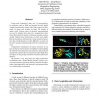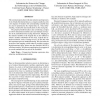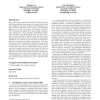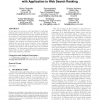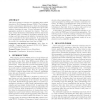116
Voted
CLEF
2006
Springer
15 years 4 months ago
2006
Springer
In this paper we present the use of a "general purpose" textual entaiment recognizer in the Answer Validation Exercise (AVE) task. Our system has been developed to learn...
125
Voted
AUSDM
2006
Springer
15 years 4 months ago
2006
Springer
In response to the rapid development of DNA Microarray technology, many classification methods have been used for Microarray classification. SVMs, decision trees, Bagging, Boostin...
115
Voted
BIBE
2004
IEEE
15 years 4 months ago
2004
IEEE
Large-scale biomedical data sets of macromolecular structures such as DNA and proteins describe highly complex biomolecular entities which often consist of thousands of atoms and ...
108
click to vote
ICIP
2007
IEEE
15 years 4 months ago
2007
IEEE
This communication deals with data reduction and regression. A set of high dimensional data (e.g., images) usually has only a few degrees of freedom with corresponding variables t...
107
click to vote
GECCO
2009
Springer
15 years 4 months ago
2009
Springer
Many approaches to active learning involve training one classifier by periodically choosing new data points about which the classifier has the least confidence, but designing a co...
132
Voted
FOCI
2007
IEEE
15 years 4 months ago
2007
IEEE
AiNet is an immune-inspired algorithm for data compression, i.e. the reduction of redundancy in data sets. In this paper we investigate the compression quality of aiNet. Therefore,...
116
Voted
KDD
2010
ACM
15 years 4 months ago
2010
ACM
In this paper we propose a novel algorithm for multi-task learning with boosted decision trees. We learn several different learning tasks with a joint model, explicitly addressing...
104
click to vote
KDD
2010
ACM
15 years 4 months ago
2010
ACM
Discovering frequent patterns from data is a popular exploratory technique in data mining. However, if the data are sensitive (e.g. patient health records, user behavior records) ...
WWW
2010
ACM
15 years 4 months ago
2010
ACM
This paper presents a technique for visualizing large spatial data sets in Web Mapping Systems (WMS). The technique creates a hierarchical clustering tree, which is subsequently u...
156
Voted
ADBIS
2007
Springer
15 years 4 months ago
2007
Springer
Classification based on k-nearest neighbors (kNN classification) is one of the most widely used classification methods. The number k of nearest neighbors used for achieving a high ...

